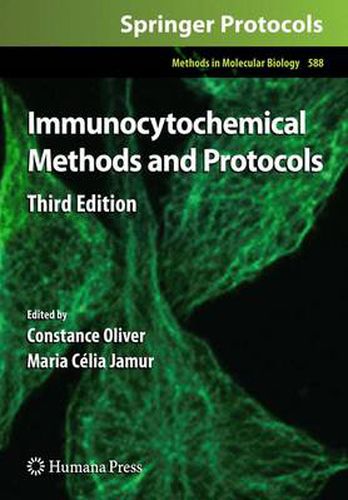Readings Newsletter
Become a Readings Member to make your shopping experience even easier.
Sign in or sign up for free!
You’re not far away from qualifying for FREE standard shipping within Australia
You’ve qualified for FREE standard shipping within Australia
The cart is loading…






This title is printed to order. This book may have been self-published. If so, we cannot guarantee the quality of the content. In the main most books will have gone through the editing process however some may not. We therefore suggest that you be aware of this before ordering this book. If in doubt check either the author or publisher’s details as we are unable to accept any returns unless they are faulty. Please contact us if you have any questions.
Antibodies tagged with fuorescent markers have been used in histochemistry for over 50 years. Although early applications were focused on the detection of microbial antigens in tissues, the use of immunocytochemical methods now has spread to include the det- tion of a wide array of antigens including proteins, carbohydrates, and lipids from virtually any organism. Today, immunohistochemistry is widely used to identify, in situ, various components of cells and tissues in both normal and pathological conditions. The method gains its strength from the extremely sensitive interaction of a specifc antibody with its antigen. For some scientifc areas, books have been published on applications of immu- cytochemical techniques specifc to that area. What distinguished Immunocytochemical Methods and Protocols from earlier books when it was frst published was its broad appeal to investigators across all disciplines, including those in both research and clinical settings. The methods and protocols p- sented in the frst edition were designed to be general in their application; the accompa- ing Notes provided the reader with invaluable assistance in adapting or troubleshooting the protocols. These strengths continued to hold true for the second edition and again for the third edition. Since the publication of the frst edition, the application of immuno- tochemical techniques in the clinical laboratory has continued to rise and this third edition provides methods that are applicable to basic research as well as to the clinical laboratory.
$9.00 standard shipping within Australia
FREE standard shipping within Australia for orders over $100.00
Express & International shipping calculated at checkout
This title is printed to order. This book may have been self-published. If so, we cannot guarantee the quality of the content. In the main most books will have gone through the editing process however some may not. We therefore suggest that you be aware of this before ordering this book. If in doubt check either the author or publisher’s details as we are unable to accept any returns unless they are faulty. Please contact us if you have any questions.
Antibodies tagged with fuorescent markers have been used in histochemistry for over 50 years. Although early applications were focused on the detection of microbial antigens in tissues, the use of immunocytochemical methods now has spread to include the det- tion of a wide array of antigens including proteins, carbohydrates, and lipids from virtually any organism. Today, immunohistochemistry is widely used to identify, in situ, various components of cells and tissues in both normal and pathological conditions. The method gains its strength from the extremely sensitive interaction of a specifc antibody with its antigen. For some scientifc areas, books have been published on applications of immu- cytochemical techniques specifc to that area. What distinguished Immunocytochemical Methods and Protocols from earlier books when it was frst published was its broad appeal to investigators across all disciplines, including those in both research and clinical settings. The methods and protocols p- sented in the frst edition were designed to be general in their application; the accompa- ing Notes provided the reader with invaluable assistance in adapting or troubleshooting the protocols. These strengths continued to hold true for the second edition and again for the third edition. Since the publication of the frst edition, the application of immuno- tochemical techniques in the clinical laboratory has continued to rise and this third edition provides methods that are applicable to basic research as well as to the clinical laboratory.